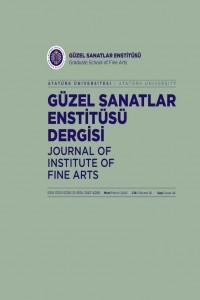HATTAT KEVKEB MEHMED EFENDİ’NİN TALEBESİ HATTAT DERVİŞ HÜSEYİN EFENDİ’YE AİT BİR KUR’ÂN-I KERİM
İslâm tarihi boyunca sultanlar, vezirler, devletin ileri gelenleri,varlıklı kişiler ve hanım sultanlar tarafından cami, medrese, tekke ve benzeriyerlere Kur’ân-ı Kerim, Buhari-i Şerîf, Delâilü’l-Hayrât vakfedilmesigeleneğini süregelmiştir. Günümüzde ise el yazma Kur’ân-ı Kerim’lerinyerini matbuları almıştır. Kastamonu Kadı Nasrullah Camii’ne vakfedilmeküzere Hacı Mehmed kızı Kerime Hatun tarafından Hattat Derviş Hüseyin binMehmed’e yazdırılan Kur’ân-ı Kerim, ferağ kaydından anlaşıldığına göre1127/1715 tarihlidir. Hafız Osman’ın talebesi Hâfız Mehmed Kevkeb’intalebelerinden olan Derviş Hüseyin, Hafız Osman mektebinin takipçisi olarakoldukça güzel bir nesih yazıya sahiptir. Harflerin bünyeleriyle birlikte harekeve tezyînî işaretler hocasının hocası olan Hâfız Osman tarzındadır. Tezhipsiz,deri ciltli olan Kur’ân-ı Kerim günümüze kadar yıpranma ve parçalanmaolmadan gelmiştir.Anahtar Kelimeler: Hattat, Derviş Hüseyin, Kevkeb Mehmed Efendi,Kastamonu.A Student of Hattat Kevkeb Mehmet Efendi A Qur’an whichBelongs to Hattat Derviş Hüseyin EfendiAbstractDuring the Islamic history, devoting the manuscripts of the HolyQuran, Holy Bukhari, Dalail al Khairat to a mosque, madrasah, dervish lodgeby the sultans, viziers, eminent bureaucrats, wealthy people and princessescontinued as a tradition. Today, the hand-written manuscripts of the Quranhave been placed by the printed copies.The manuscript of the Quran, handwritten by Islamic calligrapherDervish Hüseyin bin Mehmed under the patronage of Kerime Hatun, the daughter of Hacı Mehmed as being devoted to Kastamonu Kadı NasrullahMosque was completed in the year 1127/1715 according to its record offaragh. Dervish Hüseyin, one of the pupils of Hafiz Mehmed Kevkeb, who isthe pupil of Hafiz Osman, has a considerably beautiful naskh calligraphy as afollower of the school of Hafiz Osman. The style of the structure ofcharacters together with vowel points and decorative signs follow the style ofHafiz Osman, the master of his master. This unilluminated, leather boundmanuscript of the Quran has been reached up to date without muchdisturbance.Keywords: Calligrapher, Darwish Hussein, Kevkeb Mehmed Efendi,Kastamonu.
Anahtar Kelimeler:
Hattat, Derviş Hüseyin, Kevkeb Mehmed Efendi,
-
During the Islamic history, devoting the manuscripts of the Holy Quran, Holy Bukhari, Dalail al Khairat to a mosque, madrasah, dervish lodge by the sultans, viziers, eminent bureaucrats, wealthy people and princesses continued as a tradition. Today, the hand-written manuscripts of the Quran have been placed by the printed copies. The manuscript of the Quran, handwritten by Islamic calligrapher Dervish Hüseyin bin Mehmed under the patronage of Kerime Hatun, the daughter of Hacı Mehmed as being devoted to Kastamonu Kadı Nasrullah Mosque was completed in the year 1127/1715 according to its record of faragh. Dervish Hüseyin, one of the pupils of Hafiz Mehmed Kevkeb, who is the pupil of Hafiz Osman, has a considerably beautiful naskh calligraphy as a follower of the school of Hafiz Osman. The style of the structure of characters together with vowel points and decorative signs follow the style of Hafiz Osman, the master of his master. This unilluminated, leather bound manuscript of the Quran has been reached up to date without much disturbance.
Keywords:
Calligrapher, Darwish Hussein, Kevkeb Mehmed Efendi, Kastamonu.,
___
- Akkanat, C. (2010). “Çok Katmanlı Bir Yapı: Kastamonu’da Nasrullah Camii”, Diyanet Dergisi, Ankara.
- Altıkulaç, T. (2007). Hz. Osman’a İzâfe Edilen Mushaf-ı Şerîf, İstanbul. Dere, Ö.F. (2009).Hattat Hâfız Osman Efendi, Korpus Kitap Sanat yayıncılık, İstanbul, Derman, U. (1994). “Dervi ş Mehmed Kevkeb Efendi”, DİA, IX, İstanbul, 19
- Doksan Dokuz İstanbul Mushafı, İstanbul, 2010.
- Habib, Hat ve Hattâtân, Kostantiniyye, 1305.
- Müstakimzade Süleyman Sadeddin Efendi, ( 1928). Tuhfe-i Hattâtîn, İstanbul.
- Kanba ş, Mahmut Sami, Geçmişten Günümüze Mushaf-ı Şerîf, İstanbul. Rado, Ş. Türk Hattatları, İstanbul. Serin, M.( 2010). Hat Sanatı ve Me şhur Hattatlar, İstanbul.
- Seymen, L. (2009). Üsküdar’a Kadar Kastamonu, YKY., İstanbul.
- ISSN: 1300-9206
- Yayın Aralığı: Aylık
- Yayıncı: Atatürk Üniversitesi
Sayıdaki Diğer Makaleler
BAYBURT DAĞÇATI KÖYÜ CAMİİ VE ÇEŞMESİ / Bayburt Dağçatı Village Mosque and the Fountain
Bilal SEZER, Pelin Güleda KARADENİZ
ALEXANDER CALDER’İN AÇIK YAPITLARI (1898-1976)
Mustafa BULAT, Serap BULAT, Barış AYDIN
KEMAH ve KEMAH KALESİ KAZILARI / Kemah and Excavetıons of Kemah Castle
Hüseyin YURTTAŞ, Haldun ÖZKAN, Zerrin KÖŞKLÜ, Muhammet Lütfü KINDIĞILI
RUS NON-KONFORMİZMİ / Russian Non-Comformism
GÜMÜŞHANE/ DÖLEK KÖYÜNDE ÇÖMLEKÇİLİK / Pottery at Village Dölek/Gümüşhane
Nurşen ÖZKUL FINDIK, Zerrin KÖŞKLÜ
ŞİRVAZ KALESİ VE KAYAÜSTÜ RESİMLERİ (ŞENKAYA-ERZURUM)
Cemal SEVİNDİ, Ali Yalçın TAVUKÇU
